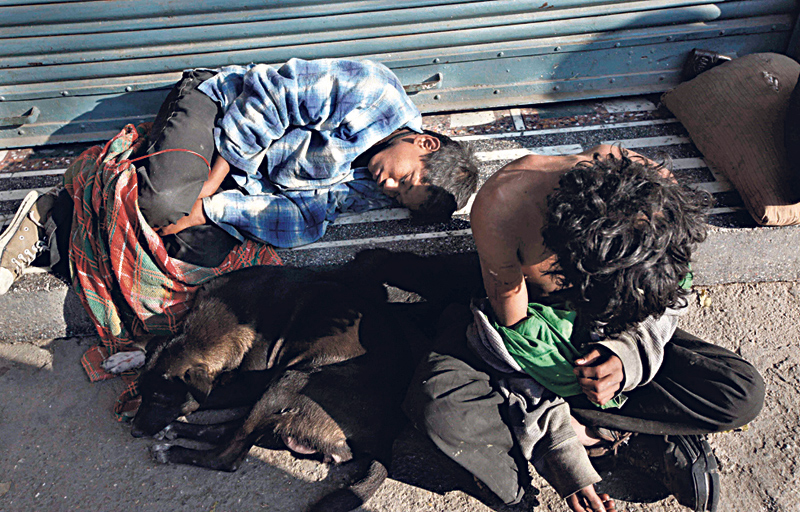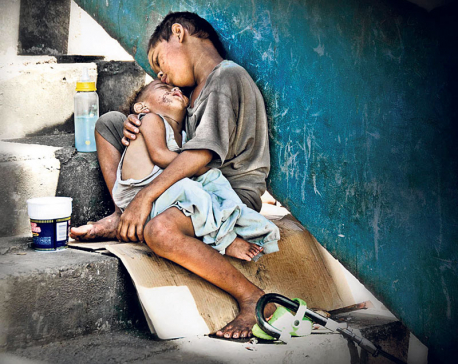
OR

KATHMANDU, March 14: As most of the street children start using psychoactive substances at a tender age of eight or nine, they are likely to get addicted before reaching 15, which ultimately reduces their average life expectancy, argue experts working for the welfare of such children.
Lack of supervision, guidance and parental care has increased the risk of substance use among children of the poor and marginalized communities. In their struggle to survive in streets they develop habits which have disastrous effects on their social life and mental ability.
A survey conducted by Child Protection Centers and Services ( CPCS) in 2012 among 302 street children of various cities found around 83% of the children smoking cigarettes regularly followed by glue sniffing (76%), while 43% consumed alcohol and smoked marijuana regularly, whereas only 4% injected drugs regularly. Although the number of street children has decreased in the recent days, these habits are still common among them.
Rajendra Shrestha, counseling therapist at Child Watabaran Center Nepal (CWCN) says, “In the beginning, street children make such wrong decisions due to peer pressure and out of curiosity. But later they start enjoying the new life and finally get addicted to it.” It has been found that most of such children are engaged in rag-picking and begging while very few of them work as conductors.
“They cannot afford to buy expensive drugs or other materials so smoking and glue sniffing is very much common among them,” Shrestha said.
According to Dr Khem Bahadur Karki, member secretary of Nepal Health Research Council, addiction of such children to illicit substances also increases social crimes and sexual exposure.
“When they cannot manage enough money for it, they start exchanging sex for drugs at an early age that too without precaution which exposes them to various sexually transmitted diseases (STDs),” said Karki.
He further informed that the excessive use of such substances damages liver, lungs, and kidneys and brain cells. “Regular use of psychoactive substances and the dust emissions in the streets is reducing the immunity of such children. As a result, they die at an early age,” Karki added.
Dr Sher Bahadur Pun, research unit coordinator at Shukraraj Tropical and Infectious Disease Hospital, said, “Most common diseases found among street children are HIV and Hepatitis but they can be treated if detected in early stage.” He further informed, “We can save such children from dying before the age of 25 by changing their habits and living style.”
Fifteen-year old Ramesh Karki (name changed) left home at a tender age of nine and started living at the Pashupatinath area. According to him, he never liked his parents as they always scolded and battered him. Karki, who is a regular drinker, said, “I also like smoking ganja with my friends sometimes as it takes me to another world where I can see and do everything that I like.”
“Rehab is not an option for them as it is too expensive and most of the organizations in Nepal cannot afford to sponsor them,” said Arjun Mohan Bhattarai, deputy country director at CPCS. He further informed that rehab centers seek for long-term commitments which cannot be expected from street children. “As a result, they keep struggling with their addiction and diseases and hence die at an early age,” Bhattarai added.
You May Like This

Underage pregnancy, abortion in street children a health concern
KATHMANDU, Aug 1: Five years ago, twelve years old Rina Dahal (name changed) of Dhading ran away from home and... Read More...

CCWB rescues 200 street children
KATHMANDU, July 23: As part of the government's plan to rescue and rehabilitate street children, the Central Child Welfare Board... Read More...

Story of Street Children
Story of Street Children Baba! Why have you left me in these streets? It’s so lonely, dark and wild ... Read More...





Just In
- MoHP cautions docs working in govt hospitals not to work in private ones
- Over 400,000 tourists visited Mustang by road last year
- 19 hydropower projects to be showcased at investment summit
- Global oil and gold prices surge as Israel retaliates against Iran
- Sajha Yatayat cancels CEO appointment process for lack of candidates
- Govt padlocks Nepal Scouts’ property illegally occupied by NC lawmaker Deepak Khadka
- FWEAN meets with President Paudel to solicit support for women entrepreneurship
- Koshi provincial assembly passes resolution motion calling for special session by majority votes






_20220508065243.jpg)






Leave A Comment